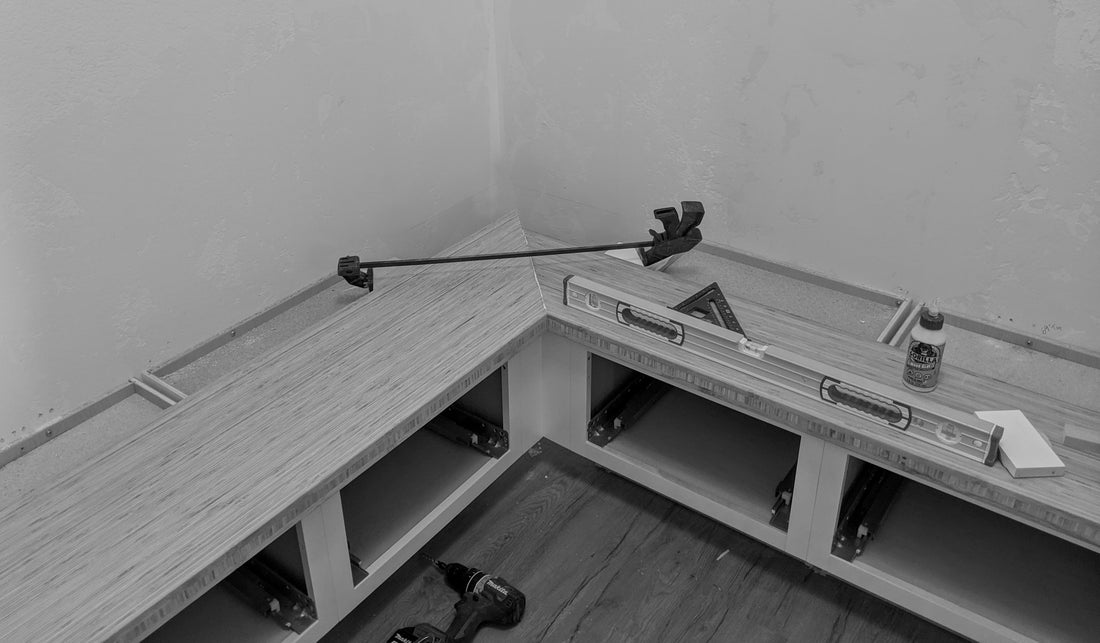What is a Scribe Tool?
The word scribe is derived from the Latin, scribere, meaning "to write". It refers to a person who keeps records, or... well, writes. Prior to the printing press, written forms of language were copied by scribes; people who meticulously copied books, letters, laws, etc by hand. Thus the word manuscript literally means "written by hand". These scribes were the earliest form of copy machines!
Okay, with that out of the way, what is a scribe tool?. Simply put, it is a marking device that allows the tracing, transferring, and/or copying of a profile onto a separate adjacent surface. It's a simple definition, but let's see what it means as for utility.
Let's look at how the use of this word falls into your craft, whatever that might be. You might find yourself saying something like, "I need to scribe a line on this surface so I know where to cut". You could substitute with words like draw, mark, or even score or scratch. The application could be a piece of tile, wood, drywall, sheet metal, glass, composite; you name it. Whatever the material, I'd bet that in most instances, you are simply using a pen or pencil and a straight-edge to create a line. Easy enough, right?
At some point, you'll encounter a situation where a straight line just won't do, and you'll be wondering, "just what the heck do I do now?". Maybe you are required to install a countertop or shelving between two walls. Based on your experience, how often would you say that all three walls are straight and planar, with the two side wall perfectly perpendicular to the back wall? Have you ever seen an inside corner without mud, tape, and texture build-up? I haven't. How about installing baseboard over LVT? Is the floor so flat and level that you could just set the baseboard down and nail it? Yeah, not too often, right? Maybe you're more advanced in the trades, and are fitting a vertical panel to a brick or dry-stacked rock fireplace. You know as well as I do that no track saw alone will suffice. Getting that right is going to take patience, as well as experience and the proper equipment.
It's in situations like these that you simply pull out your "scribe tool" and mark your cut-line right? Well, okay, maybe you just pull out a carpenter's pencil and try holding it at a consistent angle as you run it along the stone, wall, or floor. This is okay in a pinch, I guess, and it can possibly get you by. But it's not a fast, reliable, or accurate way of scribing your line. Plus, this is not likely the way you work. "Getting by" is not why you invested so heavily in high quality tools, or why you chose the line of work that you did! My guess is that there's more at stake here. Maybe it's your reputation. Maybe just the satisfaction of doing quality work.
I'm sure you've also had those occasions when you need to cut a hole around a floor drain, a can light, or a circular duct. What do you do then - dig through your hole saw collection? If the diameter is large enough, you may drive a screw into the center-point, and while holding your pencil at the correct dimension on your tape measure, you twist yourself into knots as you two-step around the workpiece; trying to maintain a neat circular form. Not such a great circle, but that was a cute little dance!
I can remember times like this, when I had been without the proper size hole saw. Shamefully, I began looking for a Pringles lid, a paint can, or even a roll of tape, just so I could get close to the right diameter. As I progressed, I kept a plastic drafting compass on hand, which set me in the right direction, but was certainly not a cure-all. If I were being honest, it caused more headache than it cured, only to end up broken in my tool bags after just a few weeks. Metal compasses faired marginally better, while offering the same (dis)ease of use.
Similar scenarios played out while installing caseworks. The base cabinets are set level, but the floor over which they stand most certainly was NOT. The true problem is revealed when installing toe kick. Sometimes, there is a 1/4" rise in the tile joint, because the tile-setter was smoking one during his lunch break. Is a carpenter's pencil, a drafting compass, or a roll of tape going to solve this? I have my doubts.
Faced with these challenges, and in a stroke of brilliance, you think to yourself, "Wouldn't it be great to have some adjustable tool that can hold a pencil at just the right distance, so I can quickly mark where to cut?". I believe we have all had these kinds of thought, or at least those of us who long for an easier, better way of doing things certainly do. This is where your journey on the web began. Casually browsing Amazon, you likely encounter a small handful of options, many of which have their strengths, but none of them are the panacea for all possible cases.
Having been in fine carpentry and cabinetry for some years, I found myself on the hunt for the perfect scribe tool, trying nearly everything that was commercially available. After countless attempts, resulting in frequent frustration and disappointment, I decided to make my own.
This is where the (short) story of the original Yerg Skrȳb begins, and where your search for the perfect scribe ends.
First, there was the initial rough sketch on a note pad, followed by sifting through pieces of wood, and purchasing off-the-shelf hardware. Next was the first round of test parts made from scraps of white oak and walnut, followed by numerous hours at the saw, router table, and drill press. Once technology became affordable, 3D prints were made. After many revisions (and almost as many failures), the marking tool now known as the Yerg Skrȳb is made available. The final product is almost as simple in form as the definition given previously, albeit more elegant. The process of development, however, was anything but simple or elegant. More on that in another post.
Somehow, you find yourself here at Yerg Tools! You have searched hard enough to be rewarded with the device that solves these profile scribing problems. Heck! You may even discover for yourself a use-case that I, its creator, overlooked!
My hope is that you will feel this unique instrument in your hand, experience its sleek performance and quality as the culmination of many years of work into a single, simple form; and finally, that your use of it will greatly enhance your work experience to the degree that you can't remember your struggles without it.
Go make something great!
